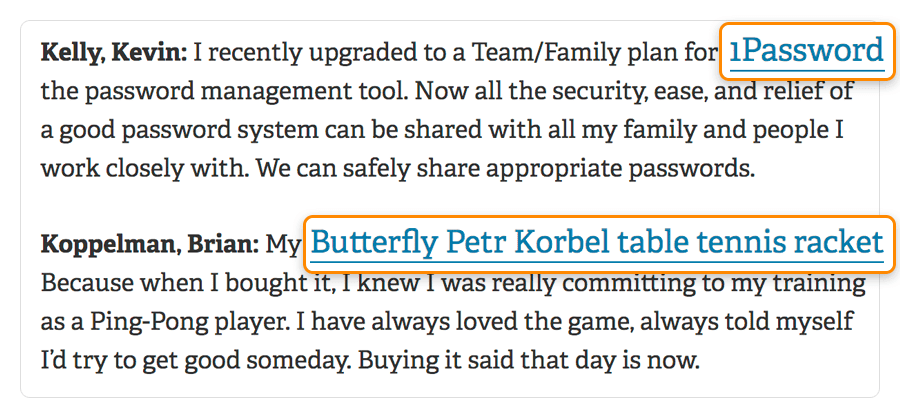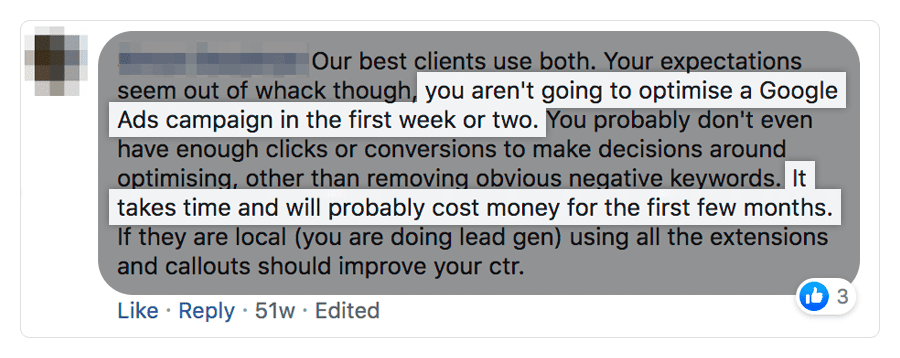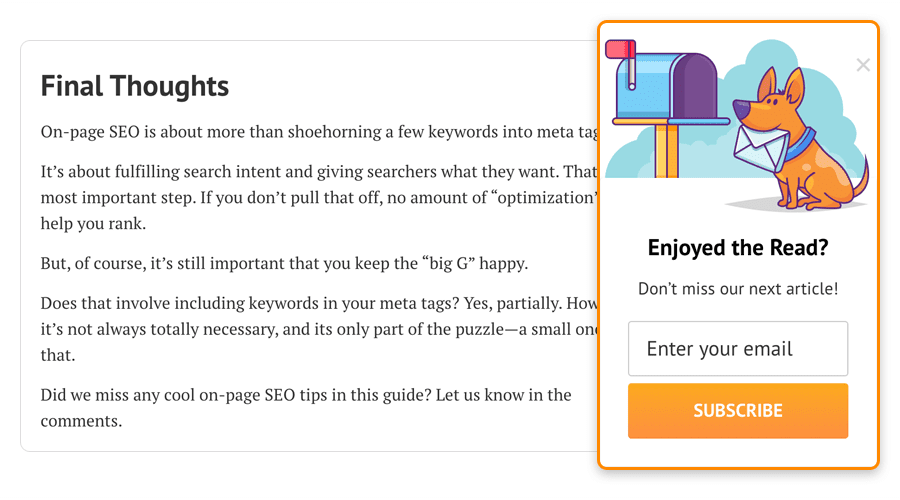Interested in tapping into the billion-dollar affiliate marketing industry? This guide will help you get started.
According to Statista, business spending on affiliate marketing will hit $8.2 billion in the U.S by 2022.
Start today, and you’ll be in a prime position to take advantage of that.
In this guide, you’ll learn how to get started with affiliate marketing in seven steps:
- Decide on a platform
- Choose your niche
- Find affiliate programs to join
- Create great content
- Drive traffic to your affiliate site
- Get clicks on your affiliate links
- Convert clicks to sales
But before that, let’s cover some basics.
Affiliate marketing is when you promote other companies’ products. When someone buys through your affiliate link, you get a commission.
As an affiliate, you’re a salesperson for the company. You help to make a sale, the company rewards you.
The best thing about affiliate marketing is that you can do it at scale. A typical salesperson only sells products from one company. As an affiliate marketer, you can promote products from many different companies and earn commissions from all of them.
The merchant gives each affiliate a unique link so they can track who was responsible for a sale. The link will usually look something like this:
When someone clicks that link, a small file called a cookie gets stored on their device.
An affiliate cookie does two things:
- It helps the merchant attribute the sale back to the right person;
- It (usually) holds an expiration date, so you get paid even if the buyer delays their purchase.
Here’s an example of how this works.
Imagine that a reader visits your post about the best winter jackets. They click on one of your affiliate links, leading them to a product on Amazon.
But they realized they have to pick up their daughter from school. So they leave their house, pick up their daughter, have dinner, and then finally go back to Amazon where they find the product again.
Since they’re already shopping on Amazon, they decide to purchase some ski gear too.
Here’s the good news. Earlier, they clicked on your affiliate link and a cookie was stored on their device. Because Amazon has a 24-hour cookie duration, you get compensated for both the winter jacket and ski gear—even though you didn’t promote the latter.
The simple answer is that there is no limit. It depends on your niche and the amount of work you put in.
The most successful affiliate marketers make six or seven figures a month.
For example, Pat Flynn from Smart Passive Income made over $100,000 in affiliate commissions in December 2017.
Ryan Robinson, another affiliate marketer, reported over $19,000 in affiliate revenue in October 2019. Another successful affiliate website—The Wirecutter—made an estimated $10 million in revenue, and was eventually sold to the New York Times for $30 million.
Keep in mind though that these people have done an excellent job building their brand. It’s taken them years of hard work to reach this level.
If you’re just starting out, your checks might look more like this for a while:
You need to manage your expectations. You won’t earn the big bucks right off the bat, but don’t let this discourage you.
The success of others tells you that with hard work, time, and the right knowledge, you too can potentially reach those levels.
Follow these seven simple steps.
- Decide on a platform
- Choose your niche
- Find affiliate programs to join
- Create great content
- Drive traffic to your affiliate site
- Get clicks on your affiliate links
- Convert clicks to sales
Step #1: Decide on a platform
Theoretically, you can do affiliate marketing on any platform. Even Instagram works.
However, it’s much easier to build an audience and increase your affiliate sales via one of two channels: a blog or YouTube channel.
Starting a blog today is relatively easy and cheap. There are plenty of tutorials online that teach you how to get started. The best part? It’ll likely only cost you a few dollars per month.
Once your site is up, optimize it for search engines so that you have a better chance of ranking. From there, you’re free to add affiliate links in your content. (There is an art to doing this, which we’ll cover later in this guide.)
The other platform is YouTube. Creating and uploading content to YouTube is free, which makes it ideal for many people. Optimize your videos for SEO, and include affiliate links in your description.
One of my favorite examples is on BookTube, where various YouTubers review books:
Note that you’ll need to disclose the fact that you’re including affiliate links. The Federal Trade Commissions (FTC) requires you to be transparent when receiving income from an endorsement.
If you’re using a blog, create a standalone page, or include it in the footer of your website like this:
Image:Farnam Street Media Inc.If you’re doing it on YouTube, include it in your description:
Now, you’ll likely get more clicks from a blog than a YouTube video. For that reason, most of the examples going forward will be for a blog.
Step #2: Choose your niche
Let’s be honest: if you’re starting a blog today, you’re facing a ton of competition. Statista estimates that the number of bloggers in the U.S will reach 31.7 million by 2020.
To stand the best chance of success, niche down.
Choose a topic that focuses on a specific category. For example, the topic of “food” is an enormous category. Rather than tackling that, try something more specific, like grilling food.
Keeping your topics tight can help you build a more focused audience and potentially help you rank higher in search engines.
That’s what I did when I built my first site. Instead of talking about “dance” or “hip hop,” I decided to limit myself to just breakdancing. Despite not knowing anything about SEO back then, I managed to rank for a few key terms and generate ~3,000 organic visits per month.
Later on, as you cover the bulk of this category and build traffic to these pages, you can expand into other areas.
Now, if you’re going to be the main content creator, choose something you’re interested in.
Many affiliate sites die due to a lack of consistency. So at the very least, if you’re passionate about a topic, you’ll find it much easier to press on when the going gets tough.
Don’t worry if you’re not an expert in the field. As Gary Vaynerchuk puts it, “document, don’t create.” Documenting what you’ve learned can make great content and attract people who are interested in following your progress.
If you’re outsourcing the content, then it’s better to work with seasoned experts in the niche. Experts can help you create high-quality, trustworthy work, which can lead to more traffic, engaged visitors, and more affiliate sales.
Step #3: Find affiliate programs to join
There are three types of affiliate programs to choose from.
A. High-paying, low-volume affiliate programs
These are affiliate programs for niche products with high payouts.
For example, ConvertKit’s affiliate program pays almost $700 per month if you send just 80 customers their way. However, as they sell CRM software for small business owners, there’s a limited pool of buyers.
There also tends to be more competition for programs with high commissions. Since you’re probably just starting, it’ll be quite challenging to make a meaningful amount of money competing against skilled marketers with deep pockets.
B. Low-paying, high-volume affiliate programs
These are affiliate programs for products with low payouts but mass appeal.
For example, take PS4 games. Lots of people play PS4, but the average cost of a game is only around $50, and affiliate commissions are usually in the single digits. This means you’ll earn $2–3 per sale if you’re lucky.
The redeeming quality of these types of programs is that they usually offer tons of products to sell. Take Amazon’s affiliate program, for example. You can earn up to 10% commissions on almost anything Amazon sells.
The other good thing is that you often get commissions on the entire value of the purchase rather than just the product you recommended.
To make these types of affiliate programs pay, you’ll need lots of traffic.
C. High-paying, high-volume affiliate programs
These are affiliate programs for products with mass appeal, which also pay high commissions.
One example is credit cards.
Everyone needs a credit card, and most people stay with the company for years (sometimes even decades!)
The downside of these types of products is that they attract affiliate marketers with lots of expertise and deep pockets. Some also use spammy tactics that you just can’t compete with.
And since this is a tutorial for beginners, I won’t go any deeper into this.
Just be aware that these programs exist.
How to decide which affiliate programs to join
This depends on your niche and level of expertise.
If you’re targeting consumers, you’ll likely go with the second model of low commissions and higher sales volume.
If you’re going after a business audience, you’ll likely go for the first model: high-paying and low volume. The most popular programs here are for software and web hosting-related products.
The best way to find these affiliate programs is with a Google search.
For example, I know that Pat Flynn promotes a number of software products on his website, Smart Passive Income. Eyeballing the Linked domains report shows that Pat links to Aweber pretty often.
Clicking the “Links from target” caret reveals that Pat is an affiliate.
It only takes a quick Google search to find an application form for this program.
However, if there is a product you’d really like to promote without a public affiliate program, reach out to the company and ask if they would be willing to build an affiliate relationship with you.
Step #4: Create great content
If you want your affiliate site to succeed, you need to create high-quality content where your affiliate links fit naturally.
Here’s an example. Tim Ferriss interviewed 100+ famous people and asked them this question:
What purchase of $100 or less has most positively impacted your life in the last six months (or in recent memory)?
He published the answers in a blog post and included affiliate links to the products mentioned:
Judging by the comments, his fans loved it.
This is what you have to emulate when creating content for your affiliate site.
Don’t just blindly curate products from Amazon’s best sellers. Go the extra mile to make sure your content solves the visitor’s problem.
How? If you’re doing reviews, actually purchase the product and test it. This is what the Wirecutter did, which explains their success.
If you don’t have money to buy every single product, you can always start with what you have at home. For example, if you had a tech blog, you could create reviews on the gadgets you own.
Step #5: Drive traffic to your affiliate site
You’ve created great content. The next step is to get more people to read it, so they will click on your affiliate links.
Here are three traffic strategies to consider:
A. Paid traffic
This is where you pay for traffic to your site. You can do this using PPC ads.
The advantage of paid traffic is that the moment you start paying, you get traffic.
However, there are some downsides.
First, running ads will dig into your profits. It’s quite normal for advertisers to lose money before they make it… if they ever do.
You need to be realistic about how long it takes to optimize a paid traffic campaign.
Secondly, once you stop paying for ads, your traffic will stop.
Generally speaking, ads are a great traffic strategy if you’re part of a high-paying affiliate program and can make the numbers work.
But if you’re completely new to paid marketing and have no marketing budget (or are working with lower commission programs like Amazon Associates), then it might not be such a great idea.
B. Search engine optimization (SEO)
SEO is the practice of optimizing pages to rank high in search engines like Google.
For as long as you can rank high in the search engines for your target keywords, you’ll get consistent and passive traffic.
On the most basic level, SEO is about:
- Understanding what your target customers are searching for;
- Creating content around those topics (blog posts, product pages, etc.);
- Taking care of the “technical” stuff to push these pages higher in the search engines (which includes link building).
Learn the basics in this video:
C. Build an email list
Email lists allow you to communicate with your readers anytime.
Use them to tell fans about new content and keep them coming back to your site for more. This leads to more affiliate clicks and sales.
You can even send affiliate email promotions to your list directly:
To build an email list, you need to persuade the readers on your site to sign up. That means offering something valuable.
At Ahrefs, we show a slide-in box at the end of every article:
Some websites like Gear Patrol also have a “subscribe” link on their navigation bar:
But there are plenty of ways to do this. You can also offer a free eBook, an email course, etc.
All you need is some creativity.
Step #6: Get clicks on your affiliate links
Just because you have an amazing piece of content doesn’t mean people will click on your affiliate links.
There are a few things you need to consider.
A. Link placement
If all your affiliate links are at the bottom of the page where people rarely scroll, clicks will be few and far between.
On the other hand, make every other word a link in your introduction, and your content will look spammy.
You need to balance link placement with the other factors below.
B. Context
Let’s say you were writing an article on the best kitchen knives for under $50.
Your introduction probably shouldn’t look like this:
Today, I’m reviewing the best chef knives.
The links look out of context and spammy.
This would make more sense:
Today, I’m reviewing three different chef knives you can buy on Amazon for under $50. These are, product name 1, product name 2, and product name 3
C. Callouts
Using callouts like buttons, tables, and boxes can help attract your readers’ attention and make the post more skimmable.
For example, the Wirecutter uses eye-catching boxes with product links anytime they share a top pick.
PC Mag takes a different approach and uses a comparison table with buttons:
Step #7: Convert clicks to sales
In affiliate marketing, two conversions need to take place for you to make money.
The first conversion is the click to the product page.
You’re 100% in control of this action. Use the tactics above to improve your chances of getting that click.
The second conversion is the visitor purchasing the product. In the case of affiliate marketing, the merchant controls the checkout, and their conversion rates are out of your control.
The trick is to play the game to your advantage and look for merchants with programs that convert well.
Here are a few ways to find them:
A. Public income reports
If people are making decent money from an affiliate program, then it’s likely that the product converts well.
How do you know if people are making money?
Look at public income reports where bloggers publicly reveal how much money they’re making from their affiliate deals.
You can find these reports on Google.
For example, if you search for “income report amazon affiliate”, you’ll see a few blog posts showing how bloggers have made money from Amazon Affiliates.
Looks like one blogger made $7,300 in a single month from Amazon commissions.
If you’re in the same space, you can also take a look at where her other affiliate income comes from, and potentially promote the same products.
B. Ask questions
If there isn’t much information available about an affiliate program you want to join, sign up and ask questions.
For example, you might want to find out what their average conversion rates are, or a ballpark figure of their top earners’ monthly commissions.
This can help you figure out if the affiliate program is worth promoting.
C. Use your intuition
Sometimes, it’s best to go with your gut feeling.
If the program or product you’re checking out feels “off,” or if you would personally never recommend the product to a friend or family member, then don’t promote it.
Final thoughts
No affiliate marketing wheels were reinvented here. These are the fundamentals, and applying them will get you off on the right foot.
Just don’t expect life-changing income or the freedom to quit your 9–5 overnight. Affiliate marketing takes time.
Focus first on making your first affiliate sale. As your site grows, set new goals, and continue experimenting.
This is how to build up a site that eventually generates a decent income.
Got questions? Let me know in the comments or contct us





























Posting Komentar
Posting Komentar